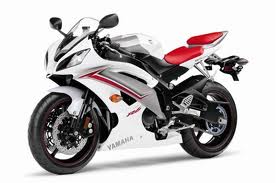Some owners have complained of a spongy front brake feel, which can be cured by fitting aftermarket brake lines. Others have bled the brakes to release trapped air every two years or so, which also helps cure the problem.
Like nearly all Yamahas, the R6 is relatively bulletproof when it comes to long-term reliability, though it's not unheard of for starters to give up the ghost, compromising other parts of the electrical system-namely batteries-if not replaced.
Around town, you could run the rpms as low as you as you want and the complete fuel injection will enable you to open the throttle anywhere, anytime without missing a beat. Of course, everything starts happening a lot quicker erst you pass 8,000 rpm and the bike pulls difficult till red line at this point but, for riding conservatively in traffic, the R6 causes a nice friend. The foot pegs are now 5mm more forward for greater weight distribution to the front end. They are surely high and the bars are low, however I found the overall ride package a lot comfier than I had thought.
You are not going to want to go touring on this thing, however don't despair if your favorite set of twisties are a couple hours away, the suspension isn't going to bushed you to death on the way. I did not maintain a lot of of an eye on gas mileage, other than getting the fuel light to come on at around 120 mph after some severe throttle abuse in the deserted canyons. This is 2000 rpm higher than the former R6 model and it is the highest redline of a widely distributed production four-stroke engine the Honda CBR250RR had a reputed redline of 19,000. Such a high speed is near to degrees known just in Formula One engines , where valve springs stress issues lead to the adoption of pneumatic return at further than 19,000 rpm.
Although total claimed horsepower of 152 hp at 10,500 rpm is only a couple of ponies up on the previous-generation bike (and still some 10 to 15 hp shy of the GSX-R), it's delivered in a much smoother, more user-friendly way than its carbureted counterpart. First impressions can be misleading: You might think the new bike has lost some of its punch. But that impression goes away when you realize just how much cornering speed you carried through that last balls-out sweeper leading to Catalunya's pit straight, or how deceptively hard the R1 accelerated out of the third-gear left leading into a long right climbing the paddock hill-a corner you'd need to take in second on most open-classers to get the kind of muscular drive the R1 delivers as second nature once its midrange chimes in at approximately 5000 rpm.
The completely revamped (but still unmistakably styled) fairing and bodywork offer a 20mm-wider nose section, which improves wind and weather protection to the rider's shoulders and head, the latter thanks to the reangled slant to the R1's snake-eye "face." But even with a wider fairing, the new R1 feels small and nimble; it remains a motorcycle you feel you can flick into a turn almost as easily as its YZF-R6 little brother. Except that now you feel much more a part of the bike, thanks in part to the revised riding position (clip-ons angled back and slanted downward, and footpegs moved back slightly), but also the narrower, resculpted fuel tank, which, at the cost of a one-liter (0.3 gallon) reduction in capacity, is much easier to snuggle up close to than its wider, bulkier predecessor. And though seat height remains the same, there's definitely less weight on your arms and shoulders, making the new R1 less tiring to ride.



No comments:
Post a Comment